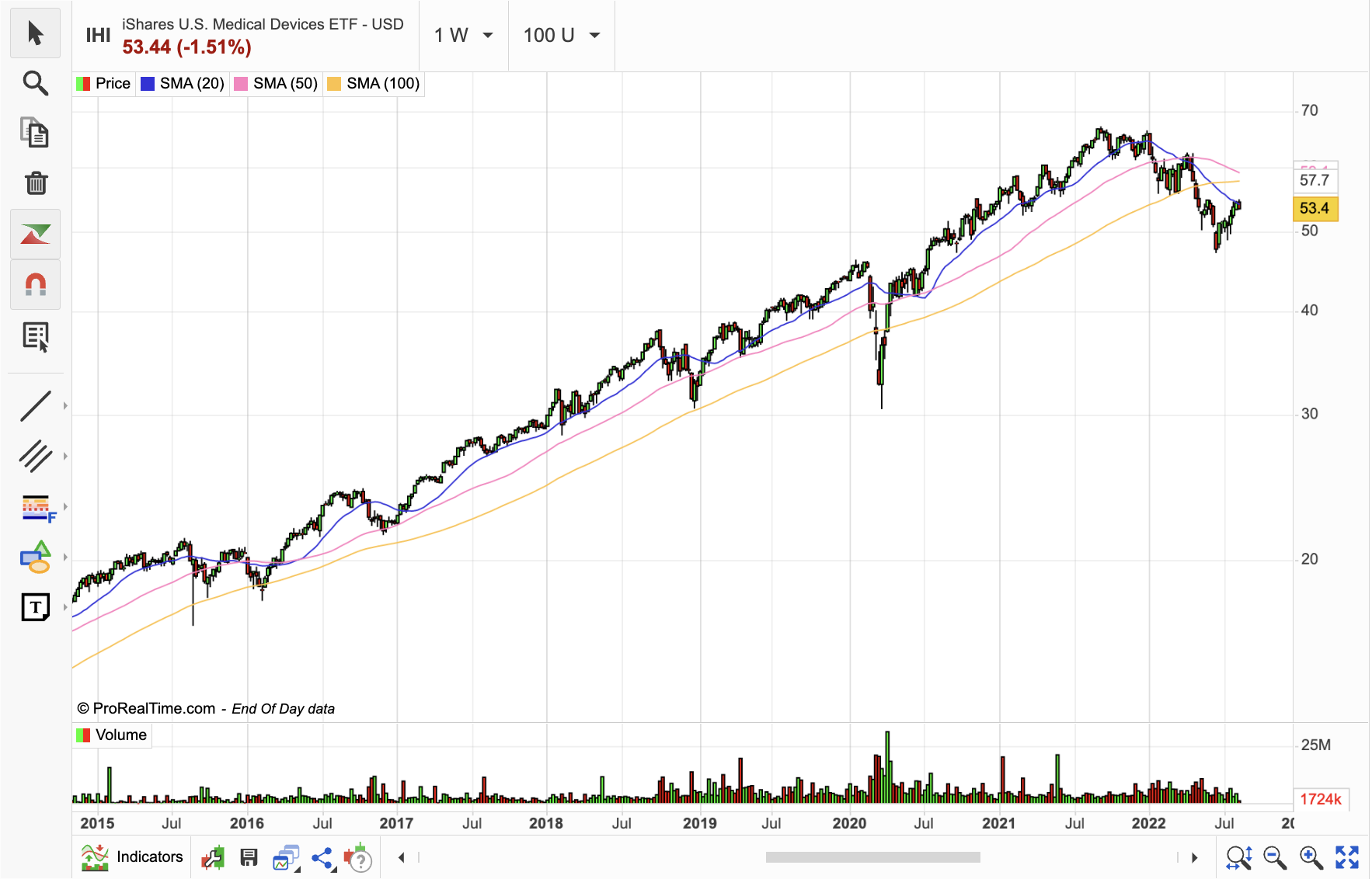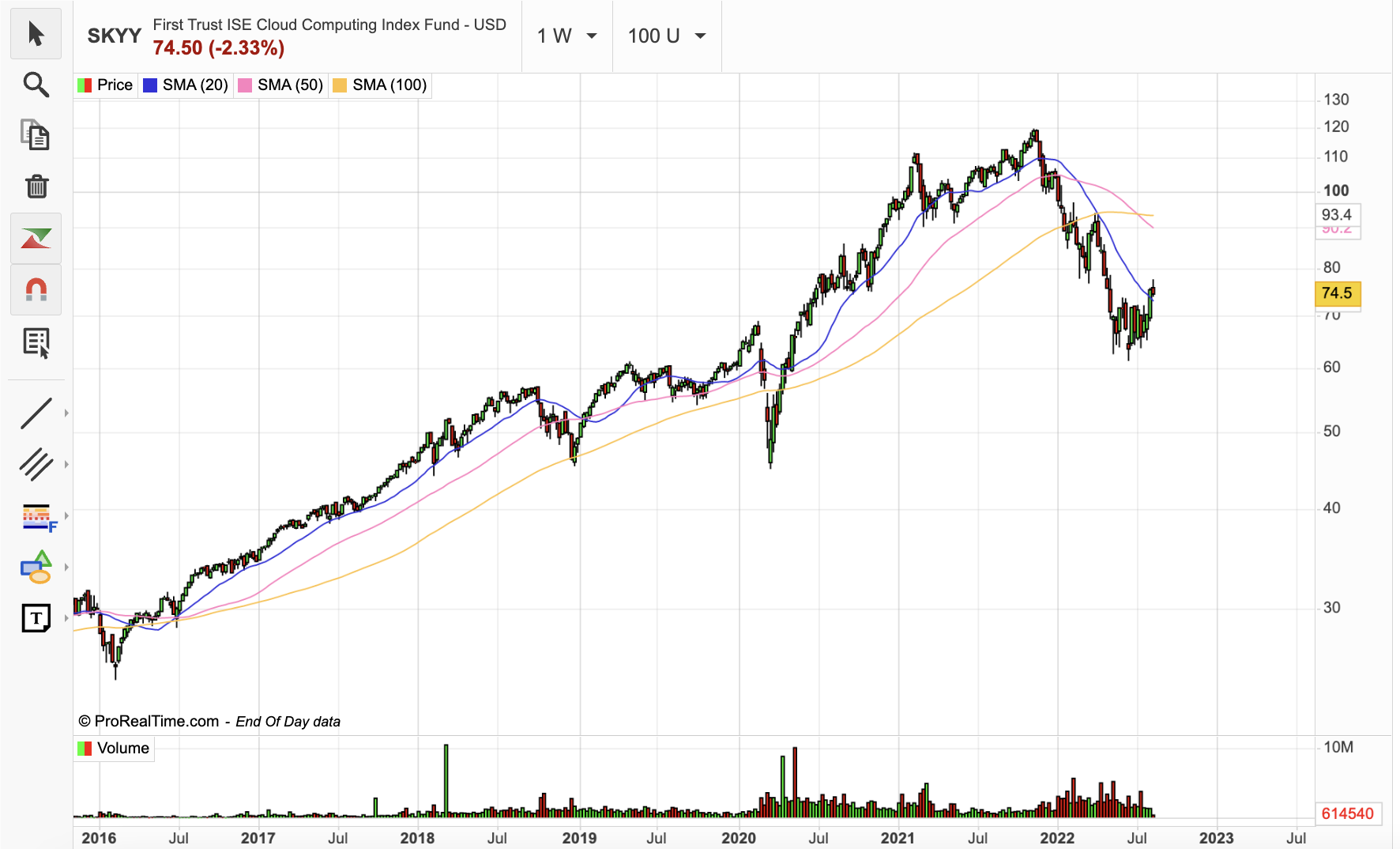Many sectors have experienced a rebound lately. Investors seem more confident than a few weeks ago. However, it is important to remain cautious and diversify its positions. In that situation, let’s look out three ETF’s which have good potential and interesting sector position. Here are three worthy propositions: Ishares U.S. Medical Devices (IHI), Ishares Cybersecurity and tech (IHAK) and the First Trust Ise Cloud Computing Index Fund (SKYY).
The Fund seeks investment results that correspond generally to the price and yield performance of the Dow Jones U.S. Select Medical Equipment Index. It generates a stream of income by distributing dividends. The ETF provides exposure to 67 companies (all listed in the US) for an AuM of $6,884 million. The three major components represent 40.87% of the ETF: Thermo Fisher (16.09%), Abbott Laboratories (14.47%), Medtronic (10.31%). The 3-years performance return is +34.69.
Abbott Laboratories and Medtronic are both world leader in designing and marketing medical equipment with strong balance sheet and offer significant visibility on their future result. Thermo Fisher has a strong customer franchise, comprehensive offering of mission-critical equipment in precision medicine, outstanding commercial reach and history of successful product launches and has an unassailable competitive advantage. It is still a fantastic business with solid growth prospects, strong structural advantages and most likely a limited exposure to cyclicality.
The medical industry adds high value to society. Artificial intelligence is a major asset and improves almost every aspect of the industry, which suffered from poor processes and rising costs. It can provide important information about disease trends and risk factors and it has now become essential to clinical practice in order to develop guidelines to ensure high-quality patient care. Also, the general population is aging, which means that the medical and healthcare sector will be among the most innovative ones.
IHI: Charts from 2015 to 2022
This ETF has been built to track an index: NYSE FactSet Global Cyber Security Index NTR. It provides physical exposure and this share class generates a stream of income by distributing dividends. Like the previous ETF presented, it's a small one with 53 holdings. The total weight of the top 15 companies is 60.10% with Citrix Systems and Check Point Software being the first and second largest. Cybersecurity's importance is on the rise. Fundamentally, our society is more technologically reliant than ever before and there is no sign that this trend will slow. Especially since the ETF announced a performance of +47% over the past three years. This ETF is also recent, as it was created in the year 2020.
Check Point System can rely on excellent fundamentals such as financial situation, profitability and EBITDA. This allows the company to generate important margins while giving it a good investment capacity. At the same time, it has one of the most attractive visibilities in its sector in terms of quality of earnings - generally above analyst consensus - low price target divergence and analyst coverage. Citrix Systems, on the other hand, has a particularly high EBITDA/sales ratio, allowing it to make strong upward revisions to earnings. Despite a somewhat high valuation (P/E ratio at 38.8x), results remain above expectations.
With an increasingly connected world, cybersecurity is becoming an essential and major asset in society. It encompasses everything that has to do with protecting our data from hackers who want to steal that information and use it to cause harm. Governments, armies, institutions, hospitals, businesses... are critical infrastructures for running our society and therefore store these huge amounts of data. We talk about protection in the form of technology and policy, meaning that advanced cyber defense programs and mechanisms must provide protection against exposure of information that can be harmful to all.
IHAK: Charts from 2020 to 2022
This ETF offered by First Trust provides exposure to equities with a total total AuM of $3,734 millions. THE SKYY offers slight diversification with 70 companies spread across one principal geography and one sector. In fact, 90.7% based in the US for 92.4% in Information Technology. This share class generates a stream of income by distributing dividends. At the same time, the 15 major companies that make up this ETF account 47.63% of it. Over ten years, it increased by 320%.
The ETF counts Alibaba, Alphabet, Oracle, Microsoft and Amazon among its main components. These technology giants are among the leaders in their sectors, with AWS (Amazon Web Services) being Amazon's cloud service and the most powerful on the market. It represents more than 40% of the revenues and houses the data of Apple, NASA or the CIA. The development of these cloud services helps improve data security, while allowing these companies to collect data to exploit it and create more powerful artificial intelligence tools.
These companies present fundamentals, consensus and extremely interesting visibility. Indeed, their operating margins, EBITDA, profitability and growth are constantly increasing. They can easily acquire new companies, and thus expand their offerings and development. At the same time, analyst coverage and revisions are constantly being revised upwards after results that are generally above expectations.
SKYY: Charts from 2016 to 2022






